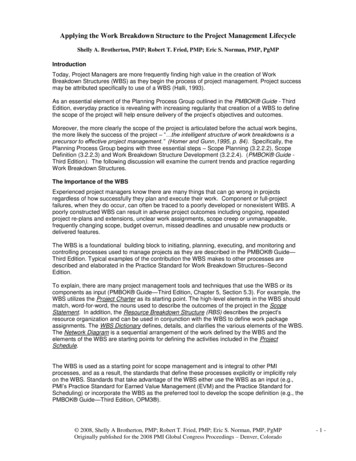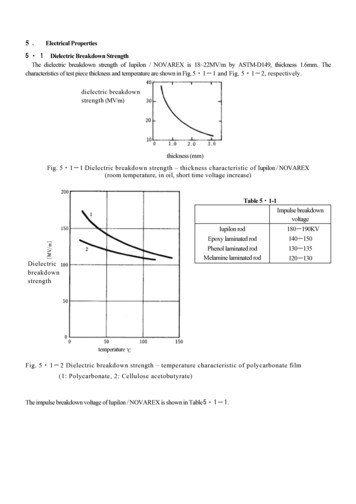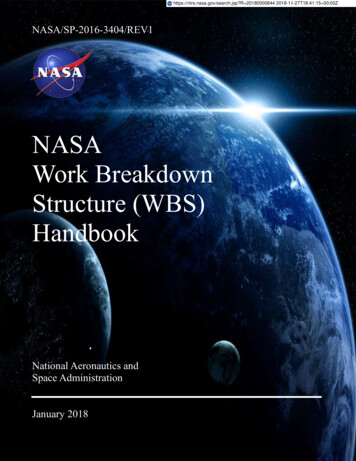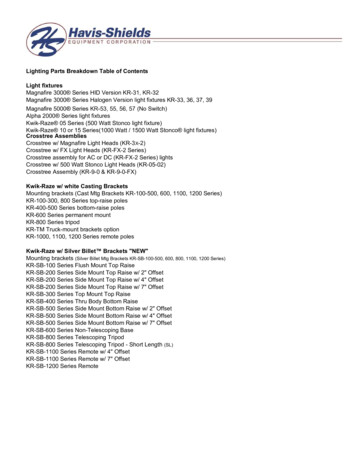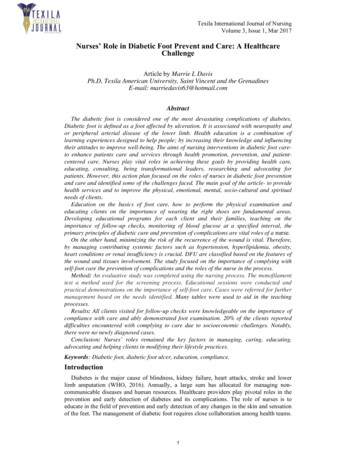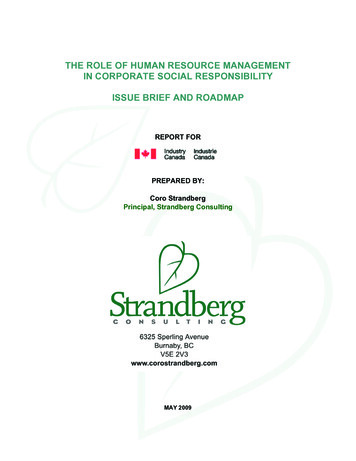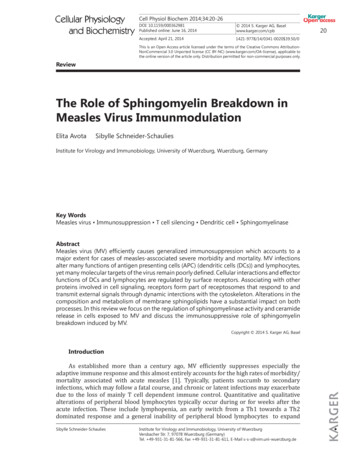
Transcription
Cellular Physiologyand BiochemistryCell Physiol Biochem 2014;34:20-26DOI: 10.1159/000362981Published online: June 16, 2014 2014 S. Karger AG, ctivationAccepted:April 21, 2014 Measles Virus in Sphingomyelinase1421-9778/14/0341-0020 39.50/0This is an Open Access article licensed under the terms of the Creative Commons AttributionNonCommercial 3.0 Unported license (CC BY-NC) (www.karger.com/OA-license), applicable tothe online version of the article only. Distribution permitted for non-commercial purposes only.ReviewThe Role of Sphingomyelin Breakdown inMeasles Virus ImmunmodulationElita AvotaSibylle Schneider-SchauliesInstitute for Virology and Immunobiology, University of Wuerzburg, Wuerzburg, GermanyKey WordsMeasles virus Immunosuppression T cell silencing Dendritic cell SphingomyelinaseAbstractMeasles virus (MV) efficiently causes generalized immunosuppression which accounts to amajor extent for cases of measles-asscociated severe morbidity and mortality. MV infectionsalter many functions of antigen presenting cells (APC) (dendritic cells (DCs)) and lymphocytes,yet many molecular targets of the virus remain poorly defined. Cellular interactions and effectorfunctions of DCs and lymphocytes are regulated by surface receptors. Associating with otherproteins involved in cell signaling, receptors form part of receptosomes that respond to andtransmit external signals through dynamic interctions with the cytoskeleton. Alterations in thecomposition and metabolism of membrane sphingolipids have a substantial impact on bothprocesses. In this review we focus on the regulation of sphingomyelinase activity and ceramiderelease in cells exposed to MV and discuss the immunosuppressive role of sphingomyelinbreakdown induced by MV.Copyright 2014 S. Karger AG, BaselIntroductionAs established more than a century ago, MV efficiently suppresses especially theadaptive immune response and this almost entirely accounts for the high rates of morbidity/mortality associated with acute measles [1]. Typically, patients succumb to secondaryinfections, which may follow a fatal course, and chronic or latent infections may exacerbatedue to the loss of mainly T cell dependent immune control. Quantitative and qualitativealterations of peripheral blood lymphocytes typically occur during or for weeks after theacute infection. These include lymphopenia, an early switch from a Th1 towards a Th2dominated response and a general inability of peripheral blood lymphocytes to expandSibylle Schneider-SchauliesInstitute for Virology and Immunobiology, University of WuerzburgVersbacher Str. 7, 97078 Wuerzburg (Germany)Tel. 49-931-31-81-566, Fax 49-931-31-81-611, E-Mail s-s-s@vim.uni-wuerzburg.de20
Cellular Physiologyand BiochemistryCell Physiol Biochem 2014;34:20-26DOI: 10.1159/000362981Published online: June 16, 2014 2014 S. Karger AG, Baselwww.karger.com/cpbAvota/Schneider-Schaulies: Measles Virus in Sphingomyelinase Activationin response to polyclonal or antigen-specific stimulation ex vivo [1, 2]. The latter twocharacteristics mark MV as a pathogen specifically targeting cellular immunity for efficientgeneralised immunosuppression.Interaction with its plasma membrane surface receptors is of major importance formeasles pathogenesis also including immunosuppression [3, 4]. Though all of them aresignaling active molecules, only three receptors confer viral uptake into target cells: CD46(used by attenuated strains in vitro [5]), nectin-4 (expressed on the basolateral side ofepithelial cells, and important for viral shedding from infected hosts [6, 7]), and CD150 (alsorefered to as SLAMF1 [8]). In vivo, MV uptake and hematopoietic spread clearly segregatewith CD150 expression patterns [9, 10]. While MV interaction with pattern recognitionreceptors such as DC-SIGN and TLR2 was linked to enhancement of viral uptake into ormaturation of APCs [11, 12], respectively, that with others such as FcgRII or an as yetundefined receptor (see below) was implicated in modulating lymphocyte viability andactivity in immunosuppression [13, 14]. Within the following paragraphs we will highlightthe role of stimulated sphingomyelin breakdown at the plasma membrane in two importantaspects of MV induced immunomodulation: DC entry and T cell silencing.MV-DC interactions: sphingolipid breakdown mediated enhancement of infectionThe importance of the MV entry receptor, CD150, for major aspects of MV pathogenesisreceived direct support from studies performed in experimentally infected rhesus macaques.CD150 expression is confined to hematopoetic cells, and predominantly activated follicular Band memory T lymphocytes are infected in secondary lymphatic tissues and, at low frequency,in PBMCs [10, 15]. Lending support to the hypothesis that APCs in the lower respiratorytract are early, if not prime target cells for viral infection, MV infected CD150 alveolarmacrophages and CD11c MHC class-II myeloid DCs were detected in peripheral tissuesearly following infection [10, 16]. This suggests that MV initially interacts with immatureDCs and exploits them as Trojan horses for transport into T cell rich areas in secondarylymphatic tissues where transmission to lymphocytes occurs [13, 14, 17, 18]. Unlike HIV, forwhich a similar scenario is postulated, MV efficiently infects DCs and this occurs in a CD150dependent manner enhanced by DC-SIGN [12, 19]. DC-SIGN, in conjunction with TLR2,may also promote phenotypic and functional DC maturation [11, 12] which resembles thatinduced by other viruses in terms of MHC- and costimulatory molecule upregulation andcytokine release, though CCR7 upregulation and CD40 signaling may be compromised [20,21]. To what extent these virus-induced alterations translate into the inability of MV-infectedDCs to stimulate T cell proliferation is unknown [13, 14]. There is, however, evidence thatthe majority of conjugates formed between T cells and infected DCs is unstable and does notsustain Ca2 -mobilization in T cells [22]. It appears that in addition to inadequate expressionand recruitment of repulsion receptors and their ligands inhibitory signals provided by theviral glycoprotein on the DC surface to conjugating T cells are essentially involved in thisprocess [23, 24], thereby rendering MV uptake for subsequent replication highly importantin DC-mediated T cell silencing.Surface expression of the MV uptake receptor CD150 is low on myeloid DCs in vitro andin vivo [19, 25], and membrane compartimentalization or clustering of this receptor has notyet been addressed on these cells. Lateral segregation followed by receptor concentrationalso including those for pathogens was, however, described following acid sphingomyelinase(ASM) activation, subsequent ceramide release and condensation of ceramide microdomainsinto extended ceramide enriched platforms [26, 27]. DC-SIGN is the major MV attachmentreceptor on DCs [19, 28]. Its signaling involves activation of c-Raf which, in general, canbe subject to ceramide mediated regulation [29, 30], and therefore, DC-SIGN appeared tobe a likely candidate in promoting sphingomyelinase activation leading to MV receptorclustering. Indeed, DC-SIGN ligation by MV, but also specific antibodies after crosslinkor mannan efficiently caused transient ASM activation and surface display of ASM and21
Cellular Physiologyand BiochemistryCell Physiol Biochem 2014;34:20-26DOI: 10.1159/000362981Published online: June 16, 2014 2014 S. Karger AG, Baselwww.karger.com/cpbAvota/Schneider-Schaulies: Measles Virus in Sphingomyelinase Activationceramides, and this was sensitive to EGTA, amitriptyline and DC-SIGN blocking antibodies[25]. Pharmacological or siRNA-mediated genetic ablation of ASM did not affect MV bindingto DCs, however, severely impaired uptake as detected by accumulation of viral proteinsafter 16 hrs. This was not observed in cell lines where the uptake receptor was abundantlyexpressed corroborating our hypothesis that DC-SIGN mediated ASM activation regulatedentry receptor availability. While lateral co-segregation of abundantly expressed CD150 andtransgenic DC-SIGN was observed after mannan exposure in Raji B cells, DC-SIGN ligationcaused a transient increase in CD150 surface display within minutes in DCs indicating thatin these cells, ASM activation caused vertical rather than lateral CD150 recruitment [25]. Itappeared that CD150 was co-transported with ASM from a common intracellular storagecompartment.There are several implications of this study that extend beyond the MV system: DC-SIGNligation is not unique to MV. Receptor sorting upon DC-SIGN mediated ASM activation andformation of ceramide-enriched platforms on DCs might well positively, but also negativelyregulate pathogen uptake. Thus, sphingomyelinase exposure caused segregation CD4 fromCXCR4 and thus inhibition of fusion-mediated HIV-1 uptake, and rather fostered viralendocytosis followed by lysosomal targeting [31]. Whether this would also occur in responseto ASM activation has not been tested, nor has it been assessed in viral systems whether ASMactivity supports membrane fusion as revealed for phago-lysosomal fusion in macrophagesinfected with L. monocytogenes [32, 33]. Thus, while consequences of DC-SIGN dependentASM activation in pathogen uptake are not MV-specific, CD150 recruitment seemingly is.Because CD150 can, however, serve as pathogen recognition receptor routing gram-negativebacteria into an endolysosomal degradative compartment in murine macrophages [34],transient availability of this receptor could be important in co-infection settings. Apart fromenhancing MV uptake, ASM activation was also found to be required for DC-SIGN proximaland downstream signaling [25]. While a role of ASM in membrane proximal c-Raf and ERKactivation was not surprising, inhibition of NF-kB upon TLR4 co-ligation was unexpected,because enhancement of LPS-driven NF-kB activation upon DC-SIGN co-ligation wasdescribed to occur in DCs earlier [30]. While reasons for these discrepant observationshave not been unraveled as yet, ASM activation in response to DC-SIGN ligation appears toregulate gene expression in DCs especially with regard to cytokine release, which, again,would be DC-SIGN, but not MV-specific.MV-interaction with T cells: actin cytoskeletal paralysis and beyondSeveral scenarios relating to MV T cell interference were described. These include 1)loss of viability occuring due to infection and/or infection-independent apoptosis. The lattercan be caused by ligation of the FcgRII [35], while infection related loss may result from viralcytolysis, formation of multinucleated giant cells or destruction by virus-specific effector Tcells in secondary lymphatic tissues [15]. Because this has been particularly revealed forthe memory T cell population, both lymphopenia but also loss of recall responses duringmeasles were attributed to this mechanism [15]. 2) A general cytokine imbalance wasdescribed in vitro and in vivo in that an initial Th1 rapidly shifts towards a Th2 responsethereby disfavoring cellular immunity [1]. 3) Thirdly, expansion of T cells isolated frompatients in response to polyclonal or antigen-specific activation is strongly impaired. Thelatter phenomenon has been mimicked by exposure of primary or transformed T cells to theMV glycoprotein complex provided by infected cells, cells transfected to express this effectorcomplex or viral particles. T cell inhibition in this system does not involve infection or celldeath, but rather a profound inability to pass beyond the G1 phase [3].It was for several reasons that regulation of phospholipid dynamics was likely ofimportance in MV T cell silencing. Binding of purified MV causes condensation of detergentresistant membrane microdomains on resting T cells and abolishes signaling initiated fromthe IL-2R and TCR at a membrane proximal level in vitro and ex vivo [36, 37]. MV targetsactivation of the PI3K, and consequently, generation of membrane phosphatidyl-inositol-22
Cellular Physiologyand BiochemistryCell Physiol Biochem 2014;34:20-26DOI: 10.1159/000362981Published online: June 16, 2014 2014 S. Karger AG, Baselwww.karger.com/cpbAvota/Schneider-Schaulies: Measles Virus in Sphingomyelinase Activation3,4,5-phosphate (PIP3) and recruitment of PH domain containing proteins (including Aktkinase and the guanosin exchange factor Vav) [37]. Akt inhibition is crucial to MV T cellsilencing, because this is efficiently abrogated upon expression of a constitutively membraneassociated, active Akt kinase [36]. As they are PI3K downstream effectors, MV impairednuclear accumulation of certain splice accessory factors thereby giving rise to production ofprotein isoforms translated from alternatively spliced mRNAs. These included a constitutivelymembrane associated active lipid phosphatase (SIP110) which on overexpression interferedwith T cell expansion, most likely by constitutively depleting PIP3 at the cell membrane [38].As a second major target of MV T cell silencing, integrity and dynamics of cortical actinproved to be effectively disturbed (refered to as T cell paralysis) which is characterized bya failure to 1) adhere to and morphologically polarise on fibronectin (FN), 2) to recruit Vavand activate small GTPases Rac1 and Cdc42 and 3) to phosphorylate ezrin/moesin proteinsand cofilin, which when dephosphorylated, severs barbed ends of actin filaments, upon TCRligation [39]. Phenotypically, MV exposure causes a rapid collapse of actin based protrusionsin T cells which, on stimulation, are unable to spread, form lamellopodia, and correctlyorganize monocentric immune synapses (ISs) with mature DCs [39]. Moreover, ISs formedbetween infected DCs and T cells were mostly unstable and did not support sustainedCa2 -fluxing thereby explaining why infected DCs do not promote T cell expansion [22, 24,40]. Because both membrane phospholipid metabolism and actin dynamics are essentialcomponents of IS function
the online version of the article only. Distribution permitted for non-commercial purposes only. Distribution permitted for non-commercial purposes only. Institute for Virology and Immunobiology, University of Wuerzburg

